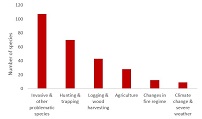
Invasive species were the most important driver of bird extinctions since 1500, being implicated in the extinction of 109 bird species. Predation by introduced rats and cats have been the most important impacts.

In total, 156 bird species are confirmed to have gone extinct since 1500. The impacts of invasive alien species, overexploitation by humans, and habitat loss and conversion driven by logging and the spread of agriculture have been the major contributory factors (see figure). Invasive species are associated with the extinction of at least 109 species. Predation by introduced rats and cats have been the most deadly factors, contributing to the extinction of some 49 and 42 species respectively. Predation by introduced dogs, pigs and mongooses, habitat destruction by sheep, rabbits and goats, and diseases caused by introduced pathogens have been implicated in some cases (Szabo et al. 2012).
The introduction of brown tree snakes (Boiga irregularis) to the island of Guam is a classic example of the devastating effect an alien predator can have on oceanic islands (Fritts & Rodda 1998). The brown tree snake has decimated bird populations on the Pacific island of Guam since it was accidentally introduced after the second world war (Rodda et al. 1998). Its exceptional predatory abilities and lack of natural enemies on Guam have resulted in the extinction of 12 of the island’s native bird species and huge population declines of eight more (Savidage 1987; Wiles et al. 2003).
The snake has more recently been recorded on several of the nearby Northern Mariana Islands (Rodda and Savidage 2007), leading to a number of species being reclassified as Critically Endangered because they are predicted to suffer extremely rapid population declines in the near future (Camp et al. 2009). Particularly at risk are those species whose populations have already shown a marked decline owing to extensive habitat clearance, such as the Mariana Crow Corvus kubaryi (Plentovich et al. 2005)
Related Case Studies in other sections
References
Camp, R. J., Pratt, T. K., Marshall, A. P., Amidon, F., Williams, L. L. 2009. Recent status and trends of the land bird avifauna on Saipan, Mariana Islands, with emphasis on the endangered Nightingale Reed-warbler (Acrocephalus luscinia). Bird Cons.Int. 19(4): 323-337.
Fritts, T. H and Dodda, G. H. (1998) The role of introduced species in the degradation of island ecosystems: a case history of Guam. Ann. Rev. Ecol. Syst. 29: 113–140.
Plentovich, S., Morton, J.M., Bart, J., Camp, R.J., Lusk, M., Johnson, N., Vanderwerf, E. (2005). Population trends of Mariana Crow Corvus kubaryi on Rota, Commonwealth of the Northern Mariana Islands. Bird Conservation International 15: 211-224.
Rodda, G. H., T. H. Fritts, and P. J. Conry. (1992). Origin and population growth of the brown tree snake, Boiga irregularis, on Guam. Pacific Science 46:46–57.
Rodda, G. H. and Savidge, J. A. (2007) Biology and impacts of Pacific island invasive species. 2. Boiga irregularis, the Brown Tree Snake (Reptilia: Columbridae). Pac. Sci. 61: 307–324. (1987)
Savidge, J. A. 1987. Extinction of an island forest avifauna by an introduced snake. Ecology 68:660–668.
Szabo JK, Khwaja N, Garnett ST, Butchart SHM (2012) Global Patterns and Drivers of Avian Extinctions at the Species and Subspecies Level. PLoS ONE 7(10): e47080. doi:10.1371/journal.pone.0047080
Wiles, J. G., Bart, J., Beck, R. E. Jr. and Augon, C. F. (2002) Impacts of the brown tree snake: patterns of decline and species persistence in Guam’s avifauna. Conserv. Biol. 17: 1350–1360.
Compiled: 2004 Last updated: 2017
Recommended Citation:
BirdLife International (2017)
Invasive alien species have been implicated in nearly half of recent bird extinctions .
Downloaded from https://datazone.birdlife.org/sowb/casestudy/invasive-alien-species-have-been-implicated-in-nearly-half-of-recent-bird-extinctions- on 22/12/2024